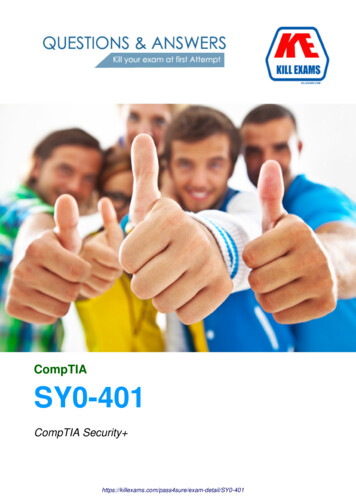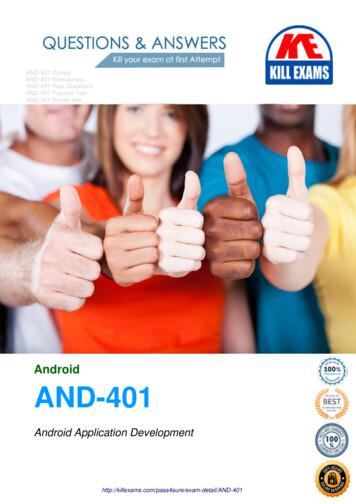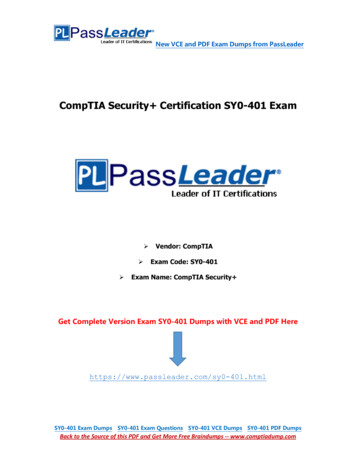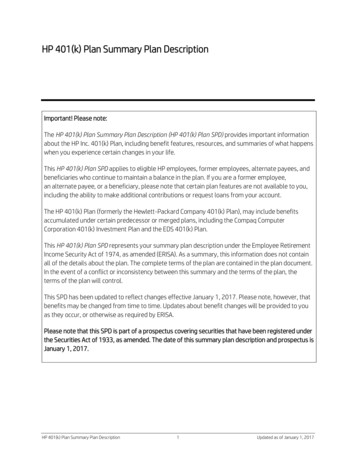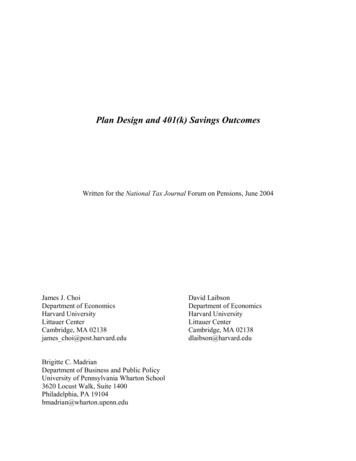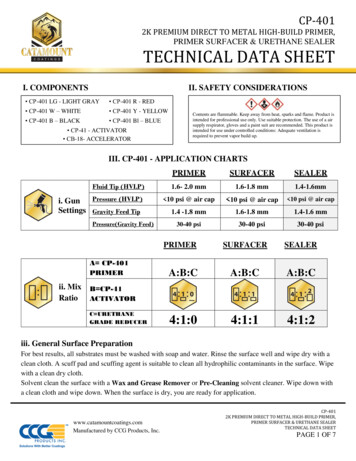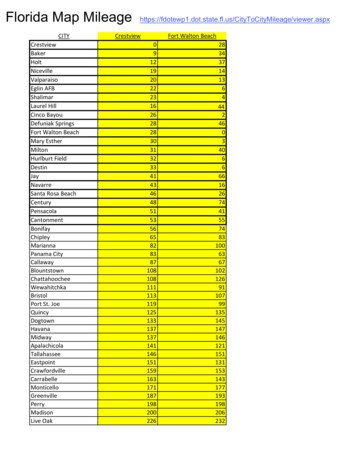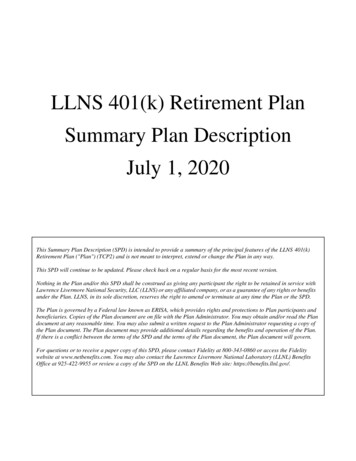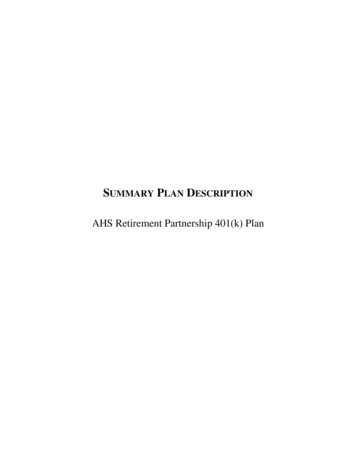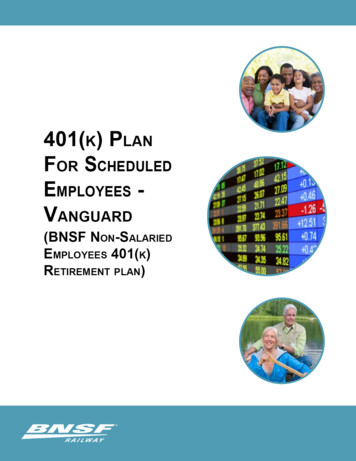
Transcription
401(k) Plan for Non-Salaried Employees1CONTENTSHOW THE PLAN WORKS IN BRIEF . 3Investing in Your Own Future . 3BNSF Rewards Your Efforts . 3You Direct the Investment of Your Account . 3Accessing Your Funds Before Retirement . 4Survivor Benefit. 4Portability and Vesting . 4PURPOSE OF THIS SPD . 5Your “User’s Guide” . 5Improving Your Benefits “Mileage” . 5The Fine Print . 5ENROLLING IN THE PLAN . 6Who Is Eligible? . 6When Does Participation Start?. 6HOW THE PLAN WORKS. 7Your Contributions . 7Before-tax Contributions . 7Non-Roth After-tax Contributions. 7Roth After-tax Contributions . 8“Catch-up” Contributions. 9Comparing the Types of Contributions You May Make . 9Company Contributions . 10Other IRS Limits. 10Impact of Contributions on Other Benefits . 11Your Accounts. 11Your Investment Choices. 12Changing Your Contributions and Investment Choices . 14Deadline for Trades in the Company Stock Fund. 1420% Limit on Company Stock Fund Investments . 14Purpose of Plan Loans and Withdrawals. 15Loans from Your Account . 15Withdrawals . 17Vesting and Your Vested Interest . 18Receiving Your Account (Distribution) . 19Payment Options . 20Taxation of Plan Distributions . 21Rollover Contributions and Distributions . 21Your Beneficiary . 23Claims Procedure . 23OTHER IMPORTANT PLAN PROVISIONS, RULES AND CONSIDERATIONS . 24Future of the Plan . 24Qualified Domestic Relations Order (QDRO) Administration . 24“Top-Heavy” Rules . 24Liens . 24Military Provisions . 24ADMINISTRATIVE INFORMATION . 25YOUR RIGHTS UNDER ERISA . 27WHOM TO CONTACT FOR ASSISTANCE WITH QUESTIONS. 28OFFICES OF THE EMPLOYEE BENEFITS SECURITY ADMINISTRATION . 28FREQUENTLY ASKED QUESTIONS AND ANSWERS . 29DEFINED TERMS . 33To Table of ContentsTo Defined Terms
401(k) Plan for Non-Salaried Employees2APPENDIX. 35Eligible Employees . 35SUPPLEMENT TO THE BNSF RAILWAY COMPANY NON-SALARIED EMPLOYEES401(K) RETIREMENT PLAN SUMMARY PLAN DESCRIPTIONTo Table of ContentsTo Defined Terms
401(k) Plan for Non-Salaried Employees3BNSF RAILWAY COMPANYNON-SALARIED EMPLOYEES401(K) RETIREMENT PLAN[401(K) PLAN FOR NON-SALARIED EMPLOYEES – VANGUARD]The Big PictureAn Overview of the 401(k) Plan for Non-Salaried EmployeesEffective January 1, 2012HOW THE PLAN WORKS IN BRIEFInvesting in Your Own FutureSetting aside money from today’s paycheck fortomorrow’s goals – such as your retirement –and choosing how to invest it makes soundfinancial sense. The BNSF 401(k) plan is a wayfor you to invest in your own future. You canmake contributions from your before-tax pay,which reduces your current income taxes andallows you to save more of your pay. You canalso make contributions from after-tax pay,either as non-Roth contributions or Rothcontributions.BNSF Rewards Your EffortsIf your collective bargaining agreement providesfor company matching contributions (seeAppendix), BNSF matches a portion of yourbefore-tax contributions and/or Roth after-taxcontributions with company-paid contributionsto your 401(k) account. Non-Roth after-taxcontributions are not matched.Under certain collective bargaining agreements(see Appendix) BNSF also makes othercontributions to your account. BNSF’scontributions amount to an immediate return onthe investments you make in your own financialsecurity.To Table of ContentsDefined terms: For the meaning of terms inblue, click to see the Defined Terms section.Links: Click on blue italic items to linkdirectly to the section or chapter indicated.Previous view: Return to your previouspage by right clicking and selecting the“previous view” option. See Search &Navigation Tips on the Plan Details(Summary Plan Descriptions) page whereyou linked to this SPD chapter.You Direct the Investmentof Your AccountYou choose how you want your 401(k) moneyinvested among 20 investment alternatives,including a variety of professionally managedmutual funds and the Berkshire Hathaway ClassB Common Stock Fund (“BRK Class B StockFund”). Investment options are selected andregularly reviewed by the BNSF EmployeeBenefits Committee. Vanguard, the Planrecordkeeper, offers you a broad array of easyto-understand investment information and usefultools to help with deciding how much youshould be contributing and how you should beinvesting that money to meet your retirementincome goals.To Defined Terms
401(k) Plan for Non-Salaried EmployeesAccessing Your FundsBefore RetirementWhile the Plan’s goal is to help you buildfinancial resources for your retirement years,there are limited ways to access money in youraccount before retirement, such as loans andwithdrawals.Survivor BenefitIf you die, 100 percent of your account value ispaid to the beneficiary you have designated.Portability and Vesting You always have 100 percentownership in the contributions youchoose to make and any relatedinvestment earnings.To Table of Contents4 You become vested (gain ownership)in any BNSF matching contributionsand any related earnings based onyour BNSF service at the rate of20 percent per year. You are 100percent vested after five years ofBNSF service, or earlier if you reachage 65, become totally disabled ordie. You are always 100 percent vested inany other BNSF contributions, ifapplicable to you, and any relatedearnings. The vested value of your account isyours to take with you when youretire or otherwise leave BNSF.To Defined Terms
401(k) Plan for Non-Salaried Employees5PURPOSE OF THIS SPDThis is the Summary Plan Description (SPD)explaining the main features of the BNSFRailway Company Non-Salaried Employees401(k) Retirement Plan, also referred to in thisdocument as the 401(k) plan for non-salariedemployees, the 401(k) plan or the Plan. Exceptas otherwise noted, this SPD describes the Planin effect as of Jan. 1, 2012.Your “User’s Guide”The SPD is a detailed guide tounderstanding and effectively using yourBNSF 401(k) benefits. As with most othertools, the better you understand howbenefits work, the better you’ll know howto use these “life tools” for meeting manypersonal and family priorities.Improving Your Benefits “Mileage”Just as your vehicle owner’s manual providestips for maintaining your investment andmaximizing its efficiency, the SPD includesinformation for getting the most from yourBNSF 401(k) benefits.The Fine PrintThe Plan is fully described in a legal PlanDocument, which includes provisions related toyour collective bargaining agreement. It is theintent of this SPD to describe accurately thebenefits and related provisions of the Plan.However, if there is any inconsistency betweenthis SPD and the Plan Document or anycollective bargaining agreement, the terms of thePlan Document or collective bargainingagreement govern. A copy of the complete PlanDocument is available from the BNSF BenefitsHelp Line at 800-234-1283, option 6.The Plan is intended to comply withSection 404(c) of the EmployeeRetirement Income Security Act of 1974(ERISA) and related U.S. Department ofLabor Regulations. Under these rules, youare responsible for any losses directlyresulting from your particular investmentdecisions, such as losses due to theperformance of a particular fund in whichyou elect to invest.Keep in mind that some of the information iscomplex because of the technical nature of thesubject matter and the legal aspects. You arewelcome to call Vanguard at 800-523-1188 ifyou have questions.To Table of ContentsTo Defined Terms
401(k) Plan for Non-Salaried Employees6ENROLLING IN THE PLANWho IsEligible?All non-salaried employees of BNSF Railway Company and any other affiliated,participating companies (collectively or individually referred to as the company)which adopt the Plan are eligible to participate in the Plan if they: Have established seniority under a collective bargaining agreement whichprovides for participation in this Plan (see Appendix); and Meet the participation requirements summarized below.Excluded persons include leased or contract employees, non-resident aliens and thosecategorized as independent contractors.When DoesParticipationStart?If you are an eligible employee, you may start participating in the Plan on the earlierof: The first day of the calendar month following one year of compensated servicewith the company (unless your collective bargaining agreement provides for ashorter period). For example, if you have no previous BNSF service and yournon-salaried service starts on Feb. 15, you may begin participating in the Plan onMarch 1 of the following year; or The first of the month after you complete 1,000 hours of service during a12-month period beginning on your employment start date or the anniversary ofthat date.When you become eligible, it is your responsibility to contact Vanguard, the Planrecordkeeper, to begin participation. Vanguard will send you an enrollment kit. Byseparate mailing, you’ll receive a personal identification number (PIN) for phonetransactions. If you wish to start contributing to the Plan after reviewing theinformation, call Vanguard at 800-523-1188 to enroll by phone. You may also enrollonline at vanguard.com. You do not need a PIN to enroll online, but you will needthe plan number 092106. Be sure to name your beneficiary when enrolling in thePlan; you can do so online as part of the enrollment process. If you die withouthaving named a beneficiary, the Plan rules will determine who will receive yourbenefit (see the section “Your Beneficiary”). The beneficiary designation form is alsoavailable on the Benefits Depot site of employee.bnsf.com Employee tab Benefitstab.To Table of ContentsTo Defined Terms
401(k) Plan for Non-Salaried Employees7HOW THE PLAN WORKSYourContributionsBefore-taxContributionsYou may contribute up to 25 percent of your compensation on a before-tax orafter-tax basis, or a combination, in any whole percentages from 1 to 25 percent.Other limits may apply, as summarized in Other IRS Limits later in this chapter.When you elect to make before-tax contributions to the Plan, in effect you elect toreduce your compensation for federal income tax purposes, and BNSF makes acorresponding before-tax contribution to the Plan on your behalf. Before-taxcontributions to the Plan are: Deducted from your compensation before federal income taxes are computed, Not considered part of your taxable income by the IRS, and Not reported as federally taxable income on your Form W-2 each year.In addition, if you are eligible (see Appendix), you may elect to have BNSF make asick leave contribution to the Plan, equal to the value of your sick leave buy-backdays, as a before-tax contribution.While not subject to current federal income taxation, before-tax contributions aresubject to current Railroad Retirement or Social Security taxes, Medicare tax andstate and/or local income taxes in certain places. In the future, when you take awithdrawal or distribution from the Plan, you must pay federal income taxes onbefore-tax contributions, company contributions, if any, and any associatedinvestment earnings. State and/or local income taxes may also be payable on thoseamounts.Consult with your professional tax advisor about the tax treatment of before-taxcontributions, including any state and/or local taxes.Your combined total before-tax and/or Roth after-tax contributions in any one yearare limited by the IRS. For example, the 2012 limit is 17,000 (except as noted underCatch-up Contributions). To see the current limits, go tovanguard.com/contributionlimits. Vanguard can also give you the currentcontribution limits by phone at 800-523-1188.Access to Before-tax AmountsYou cannot access your before-tax contributions (including catch-up contributions)and any related earnings while you remain employed with BNSF and are under age59½, except through a loan or a withdrawal due to a qualifying financial hardship.Non-RothAfter-taxContributionsNon-Roth after-tax contributions are deducted from your pay after income taxwithholding has been calculated on your gross pay. If you elect to make non-Rothafter-tax contributions, you will pay federal income taxes (as well as RailroadRetirement or Social Security and Medicare taxes) on these amounts in the year theyare earned.You will not pay income taxes on non-Roth after-tax contributions when they arewithdrawn or distributed to you from the Plan.To Table of ContentsTo Defined Terms
401(k) Plan for Non-Salaried Employees8However, investment earnings associated with non-Roth after-tax contributions aresubject to federal income taxes when they are paid to you from the Plan. Anydistribution that includes non-Roth after-tax contributions made after 1986 mustinclude a pro-rata portion of earnings, which is taxable, including an additional10 percent federal tax on early distributions, if applicable.Consult with your professional tax advisor about the tax treatment of non-Rothafter-tax contributions, including any state or local taxes.The Plan limits your non-Roth after-tax contributions, combined with any other typesof contributions you make to the Plan, to a maximum of 25 percent of yourcompensation. Other limits may apply as summarized in Other IRS Limits later inthis chapter.Access to Non-Roth After-tax AmountsYou may withdraw non-Roth after-tax contributions from the Plan at any time forany reason, except that you may make no more than one withdrawal in a calendarmonth.Roth After-taxContributionsRoth after-tax contributions are deducted from your pay after income tax withholdinghas been calculated on your gross pay. If you elect to make Roth after-taxcontributions, you will pay federal income taxes (as well as Railroad Retirement orSocial Security and Medicare taxes) on these amounts in the year they are earned.When you take a qualified distribution of your Roth after-tax contributions, neitheryour contributions nor the related investment earnings, if any, are taxable. A qualifieddistribution is one that is made at least five years after your initial Roth contributionand you must be at least age 59½ at the time of distribution (or the distribution mustbe on account of your death or disability). If the distribution is not a qualifieddistribution, federal income taxes (and possibly an additional 10 percent federal taxon early distributions) are payable on the investment earnings.Consult with your professional tax advisor about the tax treatment of Roth after-taxcontributions, including any state or local taxes.Your combined total Roth after-tax contributions and/or before-tax contributions ineach calendar year are limited by the IRS. For example, the 2012 limit is 17,000(except as noted under Catch-up Contributions). To see the current limits, go tovanguard.com/contributionlimits. Vanguard can also give you the currentcontribution limits by phone at 800-523-1188.Access to Roth After-tax AmountsYou cannot access your Roth after-tax contributions (including Roth catch-upcontributions) and any related earnings while you remain employed with BNSF andare under age 59½, except through a loan or a withdrawal due to a qualifyingfinancial hardship.To Table of ContentsTo Defined Terms
401(k) Plan for Non-Salaried Employees“Catch-up”Contributions9If you reach age 50 before the end of a calendar year, you may contribute anadditional before-tax and/or Roth after-tax amount as a “catch-up” contribution. Themaximum catch-up contribution you may make in any calendar year is whichever ofthe following is less: Up to 50 percent of your compensation; or The IRS limit (for example, 5,500 in 2012). Go tovanguard.com/contributionlimits for the current catch-up contribution limit orcall Vanguard at 800-523-1188.Comparing theTypes ofContributionsYou May MakeDo the companymatchingcontributions, ifany, apply? 1Is the money taxfree at retirement?May I withdrawmoney before Iturn age 59½ butwhile stillemployed byBNSF?Does the annualIRS limit on mycontributionsapply? (In 2012 17,000, or 22,500 if age 50 )Does the overallannual plancontribution limit of25% of compensation apply?Does the “fiveyear rule” apply?212Before-taxContributionsNon-Roth Aftertax ContributionsRoth After-taxContributionsYesNoYesNoYes forcontributions;No for investmentgains (if any)Yes 2No(Loans andhardshipwithdrawals forlimited purposesare available.)YesNo(Loans andhardshipwithdrawals forlimited purposesare available.)YesNoYesYesYesYesNoNoYesMatching contributions, in any, are always before-tax. When you take a distribution, you will owe taxes on anymatching contributions and all associated earnings.Tax implications: A distribution or withdrawal of Roth earnings usually is subject to income taxes if the initial Rothcontribution was made less than five years ago and you are under age 59½.To Table of ContentsTo Defined Terms
401(k) Plan for Non-Salaried EmployeesCompanyContributions10Company Matching ContributionsIf your collective bargaining agreement provides for company matching contributions(see Appendix), BNSF adds a 0.25 matching contribution to your account for every 1 of before-tax and/or Roth after-tax contributions you make from the first 4 percentof your compensation. BNSF’s matching contributions, if any, go into your accountat the same time as the contributions you make from your compensation.Your catch-up contributions and non-Roth after-tax contributions are not matched bycompany contributions.Other Company ContributionsIf your collective bargaining agreement calls for any other company contributions tothe Plan (see Appendix), BNSF will make these contributions as required under theagreement.Access to Matching and Other Company ContributionsAny vested matching contributions and any other BNSF contributions and earningson these contributions may be accessed while you are still employed only through thefollowing: An age 59 ½ withdrawal; A loan; or A hardship withdrawal.Other IRSLimitsIn addition to the contribution limitations described above, other IRS limits affect thePlan.Compensation LimitCompensation in excess of the IRS limit in any plan year may not be used indetermining your before-tax and/or Roth after-tax contributions (including catch-upcontributions), non-Roth after-tax contributions or any company contributions. Forexample, the 2012 compensation limit is 250,000. Go tovanguard.com/contributionlimits to see the current limit or call Vanguard at800-523-1188.Overall Contribution LimitThe total amount of your before-tax contributions (other than catch-up contributions),non-Roth after-tax contributions, Roth after-tax contributions (other than catch-upcontributions), company matching contributions (if any), and any other companycontributions in one year may not exceed an IRS limit. For example, in 2012, thatlimit is 50,000. Vanguard can give you the current limit atvanguard.com/contributionlimits or by phone at 800-523-1188.Limits on Highly Compensated Employees (HCE)Certain HCEs may be subject to additional restrictions. For 2012, the IRS defines anHCE as an employee who earned 115,000 or more in the previous plan year.Vanguard can give you the current HCE threshold at vanguard.com/contributionlimitsor by phone at 800-523-1188. Before-tax and/or Roth after-tax contributions (otherthan catch-up contributions) by HCEs may be limited, based on the averagepercentage of compensation contributed to the Plan by non-HCEs.To Table of ContentsTo Defined Terms
401(k) Plan for Non-Salaried Employees11If you are an HCE, this limit may require that a portion of your before-tax and/orRoth after-tax contributions and related earnings (if any) be returned to you from thePlan. Any company matching contributions and related earnings associated withreturned before-tax and/or Roth after-tax contributions are also removed from youraccount; similar limits apply to non-Roth after-tax contributions and any othercontributions. The Plan Administrator will inform you if you are affected by any ofthese limits. To the extent permitted by law, contributions that exceed the HCE limitwill be recharacterized as catch-up contributions for those who are eligible to makecatch-up contributions.Impact ofContributionson OtherBenefitsWhile your before-tax contributions to the Plan reduce your taxable pay, they do notreduce your other benefits that are based on your pay, such as Railroad RetirementBoard or Social Security benefits.Your AccountsSeparate accounts in the Plan are maintained for you as follows: Before-tax Contribution Account – Contains your before-tax contributions andany associated earnings. Before-tax Catch-up Contribution Account – Contains your catch-upcontributions and any associated earnings. Non-Roth After-tax Contribution Account – Contains your after-taxcontributions and any associated earnings. Roth After-tax Contribution Account – Contains your Roth after-taxcontributions and any associated earnings. Roth After-tax Catch-up Contributions Account – Contains your Roth after-taxcatch-up contributions and any associated earnings. Company Matching Contribution Account – Contains company matchingcontributions (if any– see Appendix) and any associated earnings. Other Company Contribution Account – Contains other company contributions(if any, see Appendix) and any associated earnings. Vested Dividends on Company Stock Account – Comprised of dividendsreceived with respect to any company stock held in the Plan on your behalf. Rollover Account – Contains amounts directly rolled over to the Plan fromanother employer’s qualified retirement plan and any associated earnings. Roth Rollover Account – Contains Roth amounts directly rolled over to the Planfrom another employer’s qualified retirement plan, or converted within the Plan,and any associated earnings. Trustee Transfer Account – Contains contributions directly transferred to thePlan from another employer’s qualified retirement plan and any associatedearnings.Certain additional accounts may be maintained on behalf of former participants in theBurlington Northern Inc. Thrift and Profit Sharing Plan I, and the Santa Fe PacificRetirement and Savings Plan for Salaried Employees. These plans were combinedinto the Plan effective Jan. 1, 1997:To Table of ContentsTo Defined Terms
401(k) Plan for Non-Salaried Employees12 IRA Account – Contains deductible contributions made by plan participants priorto Jan. 1, 1987. ESOP Account – Contains participant assets previously maintained underEmployee Stock Ownership Plans (ESOP) maintained by BNSF predecessorcompanies. Flex Account – Contains previous contributions under the cafeteria planmaintained by Burlington Northern Inc.Quarterly Account StatementShortly after the end of each calendar quarter, you will be sent a statement * showingthe following for each of your accounts: The balance at the beginning of the quarter, Your contributions, any company matching contributions and any other companycontributions added to the account during the quarter, The investment return credited or debited to the account during the quarter, The balance at the end of the quarter, Any outstanding loan balance, and Your vested amount in the Plan.YourInvestmentChoicesYou decide how all amounts in your account are invested, including yourcontributions, BNSF’s matching contributions (if any) and any other BNSFcontributions among the Plan’s investment funds. You may divide your contributionsamong the following funds in increments of 1 percent: BNSF Fixed Fund – Seeks to provide current and stable income, whilemaintaining a stable share value of 1. Vanguard Total Bond Market Index Fund – Seeks to track the performance ofa broad, market-weighted bond index. Vanguard WellingtonTM Fund – Seeks to provide long-term capitalappreciation and reasonable current income. Vanguard Target Retirement Trusts –The Vanguard Target RetirementIncome Trust seeks to provide current income and some capital appreciation,while each of the other Target Retirement trusts seek capital appreciation andcurrent income consistent with its current asset allocation. You pick the fund thatis closest to your expected retirement date; the mix of investments in the fund isgradually and automatically adjusted to become more conservative as yourretirement nears: *Vanguard Target Retirement Income Trust IVanguard Target Retirement 2005 Trust IVanguard Targe
401(k) Plan for Non-Salaried Employees 5 To Table of Contents To Defined Terms P URPOSE OF T HIS SPD This is the Summary Plan Description (SPD) explaining the main features of the BNSF Railway Company Non-Salaried Employees 401(k) Retirement Plan, also referred to in this document as the 401(k) plan for
